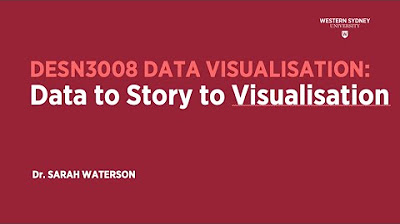DataVis Pod 01
Summary
TLDRThis lecture introduces the fundamentals of data visualization, exploring its significance in the modern digital world. It emphasizes the growing volume of data and the role of designers in presenting it effectively. The video covers key differences between data visualizations and infographics, explains how to interpret data, and outlines the designer's responsibilities. It highlights how visualization can clarify complex data, making it accessible and actionable. The lecture also touches on common visualization types, such as bar charts and line charts, stressing the importance of context and audience recognition in design decisions.
Takeaways
- 😀 Data visualization is an essential tool for communicating complex information clearly and efficiently.
- 😀 The amount of data available today is growing exponentially, requiring better visualization strategies to manage it.
- 😀 Data is the raw input, which becomes information when interpreted, and knowledge when it is presented in a meaningful way.
- 😀 Data visualization involves transforming data into visuals, such as charts or graphs, to make it accessible and understandable.
- 😀 Not all information visualizations are based on data, but all data visualizations are considered information visualizations.
- 😀 The primary goal of data visualization is to help users analyze and reason about data through visual representation.
- 😀 The bar chart is one of the most effective and simple forms of data visualization for comparing two variables.
- 😀 Line charts and timelines are great for showing data over time, such as trends or patterns.
- 😀 Visualization design needs to consider both aesthetics and ethics, ensuring that data is represented accurately and without bias.
- 😀 Effective visualizations help reveal trends, make comparisons, and can highlight causality or connections within data.
- 😀 Data visualization is both an art and a science, requiring designers to choose the appropriate visualization type based on the data and the story they want to tell.
Q & A
What is data visualization?
-Data visualization is the practice of creating graphical representations of data to communicate information clearly and efficiently. It helps in analyzing, interpreting, and presenting complex data in an accessible way.
What is the main goal of data visualization?
-The primary goal of data visualization is to communicate information clearly and efficiently using statistical graphics, plots, and information graphics, enabling users to analyze and understand data better.
How does data visualization differ from an infographic?
-Not all information visualizations are based on data, but all data visualizations are information visualizations. In contrast, infographics may not always rely on data but can instead communicate processes or ideas without quantitative data.
What is the difference between data, information, and knowledge in the context of data visualization?
-Data refers to raw measurements or values with no inherent meaning. Information is data that has been interpreted and structured, making it meaningful. Knowledge is the understanding or insights derived from interpreting and analyzing information.
Why is understanding the difference between data visualization and infographics important for designers?
-Understanding the distinction helps designers select the right approach for visualizing data. Data visualizations aim to present measurable data, while infographics may focus on communicating ideas or processes that don't always involve data.
How has the amount of available data changed in recent years?
-The amount of data available today has grown exponentially. For example, 23 exabytes of information were recorded in 2002, and now that much data is generated every seven days. This massive data growth is a result of digital technology and online activity.
What does the term 'data wrangling' mean in data visualization?
-Data wrangling refers to the process of cleaning, organizing, and transforming raw data into a structured format that can be used effectively in visualizations.
Why are bar charts often considered an effective data visualization tool?
-Bar charts are effective because they clearly represent comparisons between different categories, making it easy to identify trends or differences in data, especially when dealing with two variables.
What is the significance of knowing how your audience reads visualizations?
-Understanding how the audience interprets visualizations is crucial for effective communication. Using familiar formats, such as bar charts or line graphs, ensures the audience can easily grasp the data being presented.
What are some of the ethical and analytical challenges for data visualization designers?
-Designers face challenges in representing data accurately without misleading or oversimplifying information. They must ensure that visualizations are honest, clear, and do not obscure important details or create false impressions.
Outlines

هذا القسم متوفر فقط للمشتركين. يرجى الترقية للوصول إلى هذه الميزة.
قم بالترقية الآنMindmap

هذا القسم متوفر فقط للمشتركين. يرجى الترقية للوصول إلى هذه الميزة.
قم بالترقية الآنKeywords

هذا القسم متوفر فقط للمشتركين. يرجى الترقية للوصول إلى هذه الميزة.
قم بالترقية الآنHighlights

هذا القسم متوفر فقط للمشتركين. يرجى الترقية للوصول إلى هذه الميزة.
قم بالترقية الآنTranscripts

هذا القسم متوفر فقط للمشتركين. يرجى الترقية للوصول إلى هذه الميزة.
قم بالترقية الآن5.0 / 5 (0 votes)






